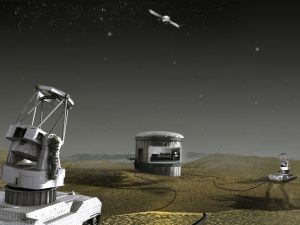

An artist's conception of a Galileo telescope tracking a defunct geostationary satellite (Credits: DARPA).
In support of its Phoenix project, which aims to salvage defunct satellites on orbit to provide parts for newer satellites, the US Defense Advanced Research Projects Agency (DARPA) is calling for the development of a ground-based network of next-generation telescopes that could more accurately observe and track the myriad of so-called “zombie satellites” in near-geosynchronous orbit. The telescope system, dubbed “Galileo”, would provide enough information on the orbital parameters and rotational behavior of defunct satellites to determine if salvaging them is possible.
“We know the fiber-optic control community is engaged in precision control of light,” said Lt. Col. Travis Blake, program manager at the DARPA. “If those solutions could be meshed with the unique demands of astronomic imaging, we could develop a new means of better, faster imaging of objects in [geosynchronous orbit].”
Modern long-baseline interferometers use evacuated “light pipes” that transport the light from connected telescopes to the interferometer, allowing them to measure the relative phase of light reflected off an object and generate high quality images. However, the use of rigid light pipes constrains the motion of the telescopes to a single axis, forcing them to rely on the relative motion of the observed object through the sky to create the different phase measurements required for synthesis. Because geostationary satellites appear stationary in the sky when observed from Earth, current long-baseline interferometers are unsuitable for observations of such satellites.
Instead, DARPA aims to develop mobile telescopes mounted on tank-like platforms that would use flexible fiber-optic cables in place of light pipes to transmit the light back to the interferometer. The added mobility would allow the Galileo system to produce high-quality images of satellites in geostationary orbit, and determine the object’s orbital and rotational parameters precisely enough for a servicing satellite to intercept and salvage the satellite.
The goal of DARPA’s Phoenix program is to develop the ability to harvest useful components from nonfunctional satellites and attach them nanosatellites using a separate servicing satellite. Such a capability would allow for satellites small enough to “ride along” on commercial satellite launches to be assembled in orbit at greatly reduced cost and weight.
If successful, the Phoenix program could make the deployment of large numbers of low-cost small satellites more economically feasible, which would further the aims of DARPA’s proposed “F6” architecture. The F6 architecture seeks to substitute a single large satellite with clusters of resource-sharing microsatellites, to reduce the risk of single-point failures of satellite system and develop a more robust, adaptable space segment.
The video below shows an animation of DARPA’s proposed Phoenix program.

















































































































![A trajectory analysis that used a computational fluid dynamics approach to determine the likely position and velocity histories of the foam (Credits: NASA Ref [1] p61).](https://www.spacesafetymagazine.com/wp-content/uploads/2014/05/fluid-dynamics-trajectory-analysis-50x50.jpg)



Leave a Reply